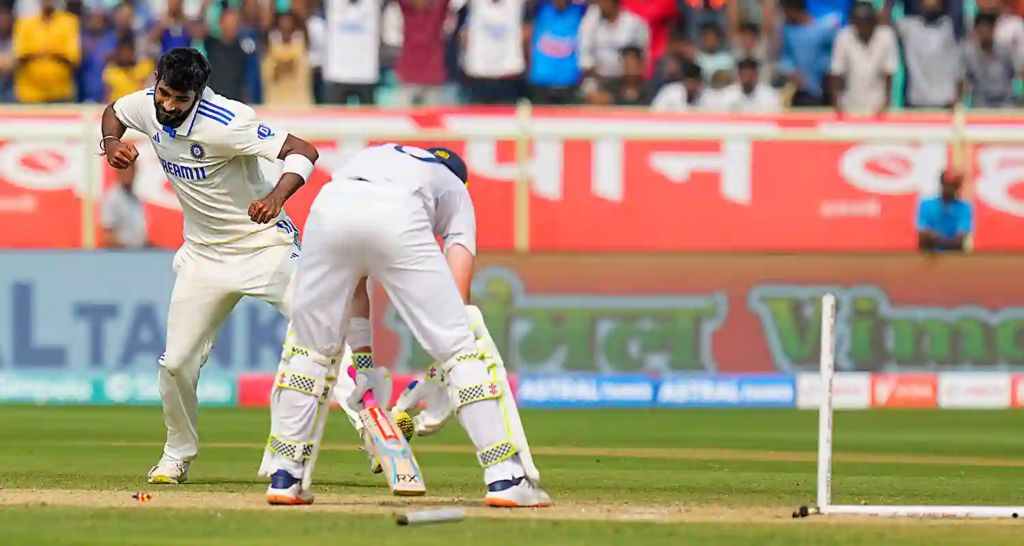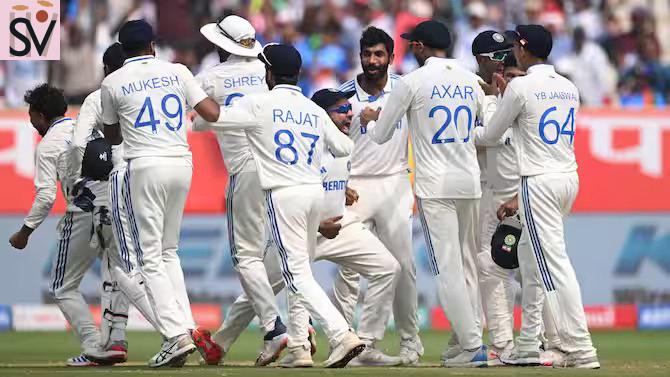The second Test match between India and England proved to be a roller-coaster of emotions for cricket fans worldwide. With stellar performances from young gun Yashasvi Jaiswal and the reliable Shubman Gill, India emerged victorious, setting the stage for a thrilling series. Let’s delve into the exciting details of this gripping encounter.
First Innings 🏏
In the first innings of the second Test between India and England, the hosts won the toss and opted to bat, a decision that set the tone for their dominance throughout the match. The spotlight, without a doubt, belonged to the young batting sensation, Yashasvi Jaiswal, who crafted a splendid innings of 209 runs. Jaiswal’s knock was a blend of sublime shot-making and unwavering determination, steering India to a commanding total of 396 runs. His innings not only showcased his immense talent but also highlighted the depth in India’s batting lineup.
England, in response, faced a challenging task against the potent Indian bowling attack. Despite some resistance, the English batsmen struggled to establish partnerships, and the relentless pressure from bowlers like Bumrah and Shami eventually limited them to 253 runs. India’s disciplined bowling performance ensured that they maintained the upper hand, setting the stage for an intriguing second innings.

The first innings of the match served as a testament to India’s all-around strength, with both bat and ball. Jaiswal’s breathtaking double century, complemented by the team’s collective effort, laid a strong foundation for the rest of the Test. As the match progressed, it became evident that India had seized the momentum, leaving cricket enthusiasts eagerly anticipating the unfolding drama in the subsequent innings.
England Innings🩵
In response to India’s formidable total of 396 runs in the first innings, England found themselves grappling with the relentless onslaught of the Indian bowling attack. The opening pair of Bumrah and Kuldeep Yadav spearheaded the assault, consistently maintaining a high level of intensity and precision. The English batsmen struggled to counter the disciplined line and length, and as a result, they could only muster a total of 253 runs in their first innings. The consistent pressure applied by the Indian bowlers prevented England from forming substantial partnerships, restricting their ability to build a solid foundation for a competitive response.
The pace duo of Bumrah and Kuldeep Yadav played a pivotal role in disrupting the rhythm of the English batting lineup. Bumrah’s ability to generate pace and movement, coupled with Shami’s seam and swing, made them a formidable combination. The bowlers exploited the conditions effectively, extracting bounce and movement to keep the English batsmen on the back foot.

The collaborative effort from the Indian bowling unit showcased not only individual brilliance but also a strategic and coordinated approach, setting the stage for India’s dominance in the remainder of the Test match. As England faced the daunting task of overcoming a substantial deficit, the effectiveness of the Indian bowlers in the first innings became a crucial factor in shaping the narrative of the match.

Second Innings 💙
In the second innings of the second Test between India and England, the Indian batsmen continued to showcase their prowess, led by the sublime performance of Shubman Gill. After a commanding first-innings lead, India declared at 255 runs, setting England a challenging target of 399 runs for victory. Gill, the young and dynamic opener, stole the limelight with an exceptional century, adding another layer to his growing reputation as a top-order batsman. His innings was characterized by a mix of elegant strokes, solid defense, and a calm demeanor under pressure, guiding India to a commanding position.
Apart from Gill’s heroics, India’s second innings also witnessed significant contributions from the middle order, as other batsmen chipped in with valuable runs. The team’s decision to declare was a strategic move, providing the bowlers ample time to bowl out the opposition and secure a comprehensive victory. The Indian batsmen collectively demonstrated their ability to adapt to different situations, maintaining a healthy run rate while also ensuring the safety of the overall lead.

As the focus shifted to the bowling department, India’s bowlers entered the second innings with the objective of defending the challenging target. Their performance played a crucial role in building pressure on the English batsmen. The spin maestro Ravichandran Ashwin, Kuldeep Yadav and Bumrah continued their relentless effort, exploiting the conditions and making breakthroughs at crucial junctures. The second innings showcased the depth and balance in the Indian team, with both batting and bowling units working in tandem to assert their dominance.
The Chase🏏
As England embarked on the challenging chase in the second Test against India, the visitors faced the formidable task of chasing down a target of 399 runs to secure victory. The Indian bowlers, fueled by the confidence gained from a substantial lead, entered the fourth innings with the intent to capitalize on the pressure they had created in the previous sessions. The spin duo of Ravichandran Ashwin and the pace trio of Bumrah, Shami, and company orchestrated a relentless attack, making scoring difficult for the English batsmen.
Despite some resistance from the English camp, the required run rate continued to climb steadily, and the wickets column kept ticking for the Indian bowlers. The turning point of the chase came when England lost key wickets in quick succession, diminishing their hopes of mounting a successful comeback. India’s fielders complemented the bowlers with sharp catches and agile movements, adding to the mounting pressure on the English team. The strategic captaincy and shrewd field placements by the Indian skipper further intensified the challenge for the visitors, making the target appear increasingly insurmountable.

Ultimately, England fell short of the target by 106 runs, succumbing to the relentless pressure applied by the Indian bowling unit. The chase showcased the resilience and skill of the Indian team, with both seasoned and young players contributing to a collective effort that secured a crucial victory. The result not only tilted the balance of the series in India’s favor but also served as a testament to the team’s ability to perform under pressure, setting the stage for an exciting remainder of the series.
The Turning Point 😱
The turning point of the second Test match between India and England unfolded during the chase, as the visitors sought to overcome the imposing target set by India. With the required run rate steadily increasing, England was dealt a severe blow when key batsmen fell victim to the precision and skill of the Indian bowlers. Ravichandran Ashwin’s spin wizardry created a web of uncertainty for the English batsmen, extracting turn and bounce to trouble even the most experienced players.
The turning point gained momentum as the Indian bowling attack, led by Jasprit Bumrah and R Ashwin , capitalized on the pressure created by the spinners. Seam movement and well-disguised variations made life difficult for the English batsmen, resulting in crucial breakthroughs that further tilted the match in India’s favor. The fall of wickets at regular intervals exposed the vulnerability of the English lineup, highlighting the exceptional teamwork and strategic acumen of the Indian bowlers and captain.

Adding to the drama, India’s fielders showcased exceptional athleticism, converting half-chances into crucial dismissals. The fielding unit, led by a vigilant captain and agile players, played a pivotal role in building the pressure that ultimately became too much for England to handle. As the turning point unfolded, the collective effort of the Indian team in all aspects of the game became apparent, cementing their dominance and paving the way for a comprehensive victory.
In the end, the turning point encapsulated the relentless pressure applied by India, the skillful execution of plans by the bowlers, and the astute leadership on the field. It marked the phase where England’s chances of a successful chase dwindled, and India seized the opportunity to close in on victory. The turning point will be remembered as a crucial passage of play that defined the outcome of the second Test and set the tone for the remainder of the series.
The second Test between India and England unfolded as a captivating spectacle, leaving cricket enthusiasts on the edge of their seats. The comprehensive victory by India was not only a testament to their cricketing prowess but also highlighted the depth and resilience within the team. From Yashasvi Jaiswal’s spectacular double century to Shubman Gill’s commanding century, the Indian batting lineup demonstrated remarkable consistency and adaptability, setting the foundation for success.
The bowlers, led by the lethal combination of spin maestro Ravichandran Ashwin and the pace duo of Bumrah and Kuldeep Yadav , showcased their ability to dominate in varying conditions. The turning point during the chase, where England succumbed to the relentless pressure applied by the Indian bowlers, underscored the team’s strategic brilliance and collective effort. The series now stands in India’s favor, creating an air of anticipation for the upcoming matches and reaffirming their status as a formidable force in international cricket.

As the teams gear up for the next chapter in this fiercely contested series, the second Test will be remembered for the individual brilliance, team synergy, and the thrilling twists and turns that encapsulate the essence of Test cricket. The stage is set for more enthralling battles, and fans can look forward to witnessing further displays of skill, determination, and sportsmanship in the remaining matches. The conclusion of the second Test leaves cricket aficionados eager for more as the teams prepare to lock horns in what promises to be an exhilarating continuation of this fiercely contested series.
Discover more from Sporty Vaibhav
Subscribe to get the latest posts sent to your email.


